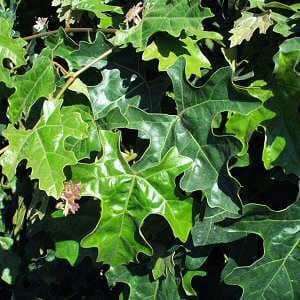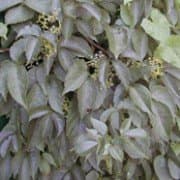Grape Vitis vinifera 'Bacchus' (O/w)

ABOUT
Vitis vinifera 'Bacchus', commonly known as the grapevine 'Bacchus', is a deciduous climbing plant known for bearing clusters of small, round grapes. The leaves of this grapevine are usually large and palmately lobed, often with serrated edges, and display a vibrant green color that can turn into hues of yellow or red during the autumn before they fall off. The surface of the leaves can be slightly leathery with a visible vein pattern. The stems of the grapevine 'Bacchus' are long and woody, and they often require support to grow upwards; they are usually trained on trellises or wires. The grapes themselves appear on the vines in tight bunches, and individual grapes are typically juicy with a sweet or tart flavor, depending on their level of ripeness. These grapes boast a thin skin and can range in color from green to gold, or even have a blush or deep purple hue, reflective of the variety. The grapevine 'Bacchus' produces delicate flowers that later develop into the fruit; these flowers are small, greenish-white, and grow in clusters. They are not particularly showy but play a crucial role in the development of the grapes. In summary, the grapevine 'Bacchus' has distinctive lobed leaves, climbing woody stems, clusters of small flowers, and bunches of round grapes that are emblematic of the species.
About this plant
 Names
NamesFamily
Vitaceae
Synonyms
Grape, Wine Grape, European Grape, Common Grape
Common names
Vitis vinifera 'Bacchus'
 Toxicity
ToxicityTo humans
The plant known as grape is not considered toxic to humans. In fact, grape berries are widely consumed as food. However, while the fruit is safe, other parts of the grape plant can be harmful. The ingestion of large quantities of grape leaves and stems could potentially lead to digestive disturbances due to the presence of tannins and other compounds. Nonetheless, it is uncommon for humans to consume enough of these parts of the plant to cause serious health issues.
To pets
The grape plant is toxic to pets, especially dogs, cats, and horses. Even small amounts of grape berries can cause acute kidney failure in these animals. Symptoms of grape poisoning in pets can include vomiting, diarrhea, lethargy, abdominal pain, and decreased urination. If a pet consumes grapes or raisins, it is essential to seek veterinary care immediately due to the potential severity of the poisoning.
 Characteristics
CharacteristicsLife cycle
Perennials
Foliage type
Deciduous
Color of leaves
Green
Flower color
Greenish-white
Height
4-6 feet (1.2-1.8 meters)
Spread
3-5 feet (0.9-1.5 meters)
Plant type
Climber
Hardiness zones
7-10
Native area
Mediterranean
Benefits
 General Benefits
General Benefits- Produces Grapes: The 'Bacchus' variety of Vitis vinifera is cultivated for its ability to produce grapes, which can be used for consumption as fresh fruit, dried as raisins, or processed to make wine, juice, jelly, and vinegar.
- Ornamental Value: With its attractive foliage and grape clusters, Bacchus grapevines can add aesthetic appeal to gardens, arbors, and landscapes.
- Erosion Control: The extensive root system of grapevines helps to stabilize soil and control erosion on slopes and hillsides.
- Shade Provision: The vine's foliage can create shaded areas when trained over pergolas or trellises, providing relief from the sun in outdoor spaces.
- Wildlife Attraction: Grapes can attract birds and other wildlife, offering them a source of food in the habitat.
- Provides Harvest Celebration: The process of growing and harvesting grapes can become a cultural or family activity, marking the seasons and providing a reason for gatherings and celebrations.
- Educational Opportunities: Growing grapes can teach important horticultural techniques and patience, as the vines require careful tending and time to mature.
 Medical Properties
Medical Properties- Cardioprotective Effects: Contains resveratrol and flavonoids that may contribute to heart health by reducing the risk of atherosclerosis and providing antioxidant properties.
- Antioxidant Properties: The presence of polyphenols such as resveratrol, proanthocyanidins, and flavonoids help in reducing oxidative stress in the body.
- Anti-inflammatory Effects: Components like resveratrol exhibit potential anti-inflammatory benefits which might be useful in managing chronic inflammatory conditions.
- Neuroprotective Potential: Proposed to protect against neurodegenerative diseases due to antioxidant content that could defend against neuronal damage.
- Glycemic Control: Polyphenols in grapes might help in improving insulin sensitivity and managing blood glucose levels.
- Antimicrobial Activity: Extracts from the grape might display antimicrobial properties against certain pathogens.
 Air-purifying Qualities
Air-purifying QualitiesThis plant is not specifically known for air purifying qualities.
 Other Uses
Other Uses- Vitis vinifera, commonly known as the grapevine, can be trained to create living arbors, providing shade and a green aesthetic in gardens and outdoor living spaces.
- The flexible young canes of grapevine are ideal for weaving into baskets and other decorative or functional wickerwork.
- Grapevine wood, when pruned, can be used as a smoking wood to add flavor to meats and other foods during the cooking process.
- Old grapevine stumps and roots are often carved into rustic artwork, furniture, or ornamental pieces for gardens.
- The leaves of grapevine can be used in composting to add a source of nutrients and improve the soil structure in gardens.
- Grapevine tendrils, the curly parts of the vine, can be collected and used in floral arrangements or as natural decorative elements in crafts.
- Dried grapevines can serve as natural fuel for fires in outdoor fire pits or for traditional bread ovens.
- The grapevine's colorful autumn foliage can be collected and used to create seasonal wreaths and other fall decorations.
- During grapevine pruning, the cuttings can be potted and rooted to propagate new vines, an economical and sustainable way to expand the vineyard or share with fellow gardeners.
- In landscaping, grapevine can be used to cover unsightly structures like fences or walls, offering a quick-growing and attractive green cover.
Interesting Facts
 Feng Shui
Feng ShuiThe common grapevine is not used in Feng Shui practice.
 Zodiac Sign Compitability
Zodiac Sign CompitabilityThe common grapevine is not used in astrology practice.
 Plant Symbolism
Plant Symbolism- Fertility and Abundance: The Vitis vinifera, commonly known as the grapevine, is often associated with fertility due to its abundant fruit production.
- Prosperity and Wealth: Grapes have historically been a sign of wealth, as vineyards require significant investment and grape products can be luxurious commodities.
- Celebration and Festivity: Grapes are used to make wine, which has connotations of celebration, revelry, and social enjoyment, often linked with the Roman god Bacchus, the god of wine.
- Transformation: The grapevine's lifecycle, from vine to grape to wine, symbolizes transformation and change, reflecting the process of growth and evolution.
- Eternal Life: In some cultures, grapevines symbolize immortality and eternal life, perhaps because of their long lifespan and ability to produce fruit for years.
- Christian Symbolism: In Christianity, wine made from grapes represents the blood of Christ, signifying sacrifice, salvation, and redemption.
 Water
WaterGrapevines, such as the Bacchus grape, generally require regular watering, especially during their first few years to establish a deep root system. It's important to water deeply once a week, providing about 1 gallon per vine if there is no significant rainfall. In hot, dry climates, water consumption may increase, and vines might need additional watering to avoid stress. Mature grapevines may require less frequent watering, depending on the weather and soil moisture levels. Excess water can lead to root rot, so ensure good drainage and allow the soil to dry out slightly between waterings.
 Light
LightThe Bacchus grape thrives in full sunlight, requiring at least 6 to 8 hours of direct sun daily. Choose a spot in your garden that is exposed to plenty of sunlight throughout the day, avoiding shaded areas which can hinder the plant's growth and fruit production. Grapes grow best with early morning sun which dries dew quickly, reducing the risk of fungal diseases.
 Temperature
TemperatureBacchus grapevines perform best in a temperate climate and can withstand a wide range of temperatures, growing successfully in areas where winter lows don’t typically drop below 20°F and where summers are warm. They can survive short periods of colder temperatures down to about 10°F. The ideal temperature range for active growth and fruit set is between 75°F and 85°F.
 Pruning
PruningProper pruning of Bacchus grapevines is essential to maintain vine health, ensure productive fruiting, and prevent disease. Prune in late winter when the plant is dormant, removing all but a few buds of the previous year's growth to encourage new fruit-producing vines. It's important to prune annually, as grapes will only grow on one-year-old canes. The best time to prune is late winter or early spring just before the buds start to swell.
 Cleaning
CleaningAs needed
 Soil
SoilGrapevines like Vitis vinifera 'Bacchus' prefer a well-draining soil mix with a component of loam and compost. It's beneficial to incorporate a slow-release fertilizer into the mix. The ideal soil pH for grapevines ranges from 5.5 to 6.5 to ensure proper nutrient uptake.
 Repotting
RepottingGrapevines such as Vitis vinifera 'Bacchus', which are typically grown outdoors, do not require frequent repotting. In a container setting, repotting might be necessary every 2-4 years as the plant outgrows its pot or the soil becomes depleted.
 Humidity & Misting
Humidity & MistingVitis vinifera 'Bacchus' thrives in moderate humidity conditions but is adaptable and can tolerate a wide range of humidity levels found in typical outdoor environments.
 Suitable locations
Suitable locationsIndoor
Provide full sun, prune regularly, ensure good air circulation.
Outdoor
Plant in full sun, well-draining soil, and provide support.
Hardiness zone
7-10 USDA
 Life cycle
Life cycleVitis vinifera 'Bacchus', commonly known as the Bacchus grapevine, begins with seed germination where warmth, moisture, and soil contact trigger the development of the root system and shoot. Following germination, the seedling grows into a young vine; during this stage, proper care and trellising are critical for establishing a strong framework for future growth. The vine then enters a vegetative phase each spring, characterized by the growth of leaves and shoots that capture sunlight and energy for photosynthesis. As the vine matures, it develops grape clusters during the flowering stage, which is followed by pollination and fruit set. The grapes then undergo a ripening process, where sugars and flavors concentrate until they reach optimal levels for harvest. Following harvest, the vine eventually enters a dormant period during the colder months, conserving resources to start the cycle anew in the spring.
 Propogation
PropogationPropogation time
Late Winter - Early Spring
The most popular method of propagating Vitis vinifera 'Bacchus', commonly known as grapevine, is through hardwood cuttings. This is typically done during the dormant season, often between late fall and late winter when the plant is not actively growing. Cuttings should be taken from healthy, disease-free plants, and should be about 12 to 18 inches long (approximately 30 to 45 centimeters). Each cutting should have at least three buds. The bottom cut of each cutting should be made just below a bud, and the top cut should be made just above a bud to maximize the potential for growth. The cuttings are then planted in well-drained soil with two-thirds of their length buried, and they are often dipped in rooting hormone to increase the chances of successful rooting. Moisture levels should be maintained until the cuttings have established a strong root system.





![Grape [Claret Cloak]](/_next/image?url=https%3A%2F%2Fplants-admin.emdemapps.com%2Fimages%2Fplants%2F%2Fimages%2F604b602abe2f8.png&w=640&q=75)



